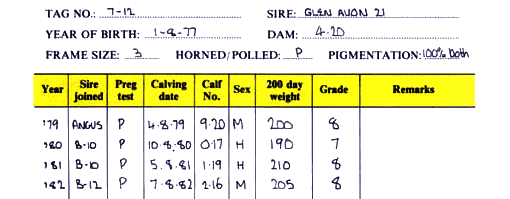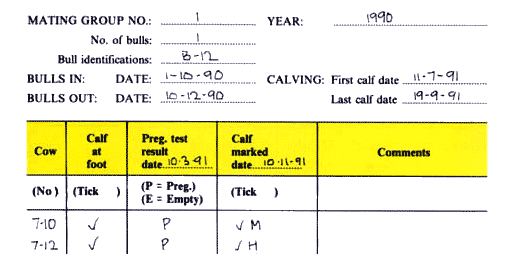
Record keeping for herd improvement
Introduction
Two Agfacts have been produced to cover the topic of ‘records for beef producers’:
- Agfact A2.8.1 Record keeping and management planning
- Agfact A2.8.2 Record keeping for herd improvement
The recording systems outlined present a package of practical records for beef producers. You can change them to suit your particular needs. The number of records maintained and the detail recorded will vary according to individual needs and how the information is to be used. Each record should have a specific objective and be used for that purpose.
While many beef producers achieve genetic improvement in their herds without keeping individual cow records, a sound management program and careful subjective selection assessment are required. Individual cow records allow for objective assessment of heritable and repeatable traits. They enable you to accurately measure genetic improvement and monitor individual cow fertility and production.
The record formats shown in this Agfact cover individual breeding cow records that can be applied to breeding herds. The emphasis is on recording production information that is useful in selection decisions for herd improvement and herd fertility monitoring.
What to record
What you record will depend on your needs and your capability to record information. The records you choose to keep should be related to the purpose you are going to use them for, such as selecting heifers, culling cows or forming a nucleus herd for breeding bulls.
Producers interested in performance recording and registering animals with BREEDPLAN will require more detailed record keeping. Information recorded should mostly be on:
- heritable traits, i.e. birthweight, calving difficulty, cancer eye
- repeatable traits, i.e. fertility, calving date
Checklist of records to keep
Cow informationGeneral records of:
| Cow performanceAnnual records of:
|
Identification
If you are going to record information about individual animals, you need to be able to identify each animal in the herd over a number of years. The easiest way to achieve this at present is to use National Livestock Identification System (NLIS) electronic devices (ear tags / rumen bolus), or plastic ear tags.
The Australian beef industry has adopted a whole-of-life identification system (NLIS). The electronic ID devices used in this system are easily linked to computer-based record-keeping systems commonly available. For further information, see National Livestock Identification System.
Ear tag identification systems
Plastic ear tags and NLIS ear tags are not loss-proof! Where permanent identification is necessary, a back-up management tag or ear tattoo is desirable.
Adopting any ear tag or NLIS identification program is pointless if you do not plan to ‘mother up’ cows with their annual calf drop, or record individual animal information.
Cows
Ear tags and NLIS tags/boluses are used to give an individual number, to indicate age and, if required, to show the breeding of the cow or cow group. For example, ‘810’ may represent cow number 10, born in 1998 — the first number shows the year of birth and the following numbers identify the individual cow.
Different-coloured tags or the addition of letters above the identification number can be used to record the sire. Cows that fail to rear a calf can have their ear tag notched to identify them for culling and disposal.
Calves
A useful alternative to the common plastic ear tag is the pink ear tag system — note that the pink ear tag system will be reviewed in 2006, in conjunction with the rollout of NLIS. Calves can be tagged with pink ear tags (the pink colour denoting HGP-free status), individually numbered in addition to displaying the tail tag number. This means you can use the ear tag instead of the tail tag, and have the benefit of using it as a management tag as well.
Calves treated with HGPs can be tagged with orange non-NLIS ear tags — these calves must have their ‘off’ ear (the right ear) punched with a triangular punch.
Two systems exist for tagging calves: tagging at birth or tagging at marking.
Tagging at birth can be done in two ways:
- Allocating permanent numbers
- Heifer calves are allocated a permanent number, e.g. for 2004 calving, numbers would start at 401 or 4001, for the first calf born
- Numbers are allocated in order of age. It is then easy to draft into age groups for ‘performance testing without scales’
- Male calves can be included in the number sequence or can be given a different set of numbers starting at 1. Linking the performance of those calves later in life to their dam is important for genetic progress
- Numbering all calves with mother’s number
- This simplifies mothering-up
- Replacement heifers are given a permanent number at their first joining
Tagging at marking:
- Calves are numbered, from 1 up, as they run through the calf race
- Odd-numbered tags can be used for steers and even-numbered tags can be used for heifers, or different tag colours can be used
- By observation, cows and calves are ‘mothered up’ during the period between marking and weaning
- When the heifers are to be joined, they can be tagged with a permanent number in line with the cow sequence
- Heifers can be permanently tagged, using the cow sequence format, at marking. For example, at the marking of the 2004 calf drop, the first heifer calf through the race would be tagged number 401
The NLIS tags can be applied at birth or at marketing — this is only done when you wish to record individual animal information.
Points to note about your identification system
- Sufficient room should be allowed on your tags for the individual cow number to appear after the year number. Herd size will determine how much room will be needed
- Your ear tag identification numbers should be the same as those shown in your office records.
- Correct tag placement will minimise tag losses and provide good legibility
Office records
Having taken the effort to implement an identification system, the next step is to decide upon a system of office records to store the information you wish to keep.
A range of options exist for keeping permanent herd records in the farm office. Traditionally the most versatile of all these options was the use of cow record cards, one card for each cow. However, with the developments in technology, both simple and advanced computer software programs for herd recording are now available. Laptop computers can also be used in the yards to avoid duplication of information.
The National Livestock Identification System provides the direct link to computerised office records.
Cow record cards
Individual breeding cow records need to be kept in a simple, easy-to-use format. Cow record cards have the following advantages:
- The full productive history of the cow can be seen at a glance
- The cards can be filed in various ways, for example in paddock groups or in number order within age groups
- As cows are culled and sold, the cards are removed from the system but are retained in order to trace family histories
- A calving notebook is used to record calving details in the paddock for transfer immediately to cow record cards
- It is easy to draft out, in the office, the top and bottom cows, older cows, and heifer replacements

An example of a cow record card is given to the right. A record card size 12.5 cm × 20 cm is recommended. On the back of the card, vaccination and health details can be recorded.
An alternative to using cards is to use pages in a loose-leaf folder, with one page per cow. This gives the flexibility to move record pages into groups, but this method is more cumbersome than a card system.
Computer programs are rapidly becoming the most preferred and reliable source of herd recording.
Bull cards
Herd bulls can also be recorded on a computer or card system. The card entries can show age, breeding description, vendor, purchase price, annual joining records, health treatments, frame size, testicular size, and details on breeding soundness and identification.
Cattle notebook
By adopting a card system in the office, all you need in the paddock and the yards is a notebook with headings drawn up for the information you want to keep. Transfer the details as soon as possible, straight onto the cow record cards or computer, taking care to avoid any duplication.
Notebooks used in the paddock and yards can be lost, damaged or fouled up easily. Use a biro, rather than a pencil, to record notebook entries. Pencil entries can become obscure if the notebook gets dirty or wet.
If you do not wish to adopt a cow card system, two other useful records you can keep are a mating group record and a calving book.
Mating group record
This is a group record and not an individual record, although it does allow you to record details on individual cows within the group (see the example below). The main advantage of a mating group record is to check on group fertility (both bull and cows).

If you use cow record cards, then keep mating group records in the notebook. This avoids duplication.
The mating group is a useful herd management record to identify bull fertility problems in both single-sire and multiple-sire joining. It also helps with examining calving spread. Not all the cows joined in each mating group will calve with other cows from that joining group.
Calving book
The calving book (see extract below) allows you to record calving details as cows calve in their calving groups. It is a paddock notebook and the key record required for a software or cow card system.
The layout illustrated is taken from the calving book produced by BREEDPLAN. The format shown is recommended because:
- it allows you to record information that is directly transferable to BREEDPLAN;
- it can be kept as a record in its own right;
- records can be transferred onto the computer or the cow record cards.
If the calving book is the only record kept, then you will have all the calves born listed together, along with a record of the cows that calved.
Cows that failed to calve need to be recorded also.
If you are interested in BREEDPLAN, contact your local Beef Cattle Advisory Officer or the Agricultural Business Research Institute, University of New England, Armidale, NSW 2351. See also BREEDPLAN.
Using the calving book

- Before calving commences, the cow identification numbers for each calving group should be written down in order.
- Daily entries made in the paddock notebook should be transferred to the master sheet or computer that night.
- A checklist can be made by listing all calf tag numbers in order, alongside dam numbers. This is done at the back of the calving book when the calves are tagged, e.g. at birth or when cow/calf pairs are mothered-up.
Remember …
Individual breeding-cow records will allow you to utilise performance information for selection. Often, records will have to be adjusted to make meaningful comparisons between individuals. Remember that comparisons can be made only between animals run together and treated alike.
Records must be relevant to your purpose and must be recorded with ease. Ease of recording is dictated by:
- the extensiveness of the property, the stocking rate, and mustering problems;
- the herd size in relation to labour available at critical times;
- the availability of convenient handling and measuring facilities.
Beef Cattle Advisory Officers are available to assist beef producers to develop recording programs for their individual herds.
Further information
See also Agfact A2.8.1 Record keeping and management planning.
Acknowledgment
This Agfact is based on an earlier print edition of Agfact A2.8.2 Records for herd improvement, written by Ian Blackwood, District Livestock Officer (Beef Cattle and Horses), NSW Agriculture.

